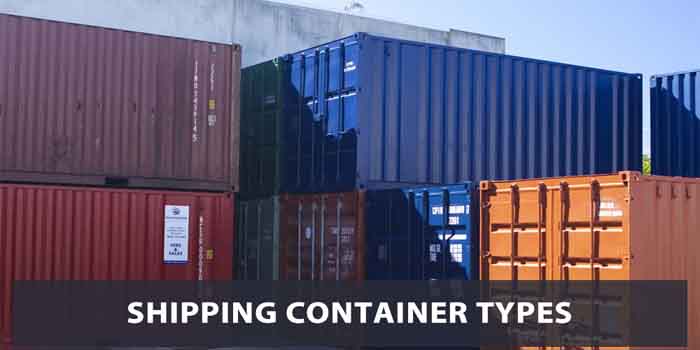Cargo or shipping containers are a perfect solution to intermodal logistics. And while they’re categorised per the construction, they come in different sizes and variations allowing for multiple shipping possibilities that go beyond the standard cargo transport. Have a look at some of the most popular and practical modifications you can find today.
1 : 10, 20 & 40-inch Dry Storage
Some of the most common shipping container sizes come in 10, 20 and 40-inch. And as the name indicates, these are used to ship dry items/goods that don’t need any temperature control or maintenance.
2 : Flat Rack
Built specially for heavyweight, bulk and over-width cargo, flat rack containers are loaded from the top which is why the roof or top-end is open. The base is made of reinforced steel to support weight as heavy as 50 tons whereas the walls at either end can be collapsible or non-collapsible depending on convenience of transportation and type of the load. Most common cargo that can be loaded on these containers includes heavy and large machinery, steel pipes, cable and bars so on.
3 : Open Top
Much like a convertible car, open top containers have a detachable weather-proof tarpaulinroof. Items to be shipped are secured with industrial-grade ropes, mostly used for cargo which exceeds the original height of ‘high-cube’ containers. The door header can be open to conveniently secure cargo. These containers are also ideal for heavy-duty machinery and bulk shipment.
4 : Tunnel
For maximum ease of shipment, cargo container suppliers prefer this option as it come with easy-to-open and secured doors that are useful especially when quick loading and unloading of the logistics is needed.
5 : Open Side Storage
This particular cargo storage unit come with makeshift doors that can be reformed only to one side. With one side open and the other closed, it’s easier to load and store wider merchandise and bulk cargo.
6 : Insulated & Thermal
These containers have temperature control and regulation system which makes them perfect for items which are to be kept at higher temperature while shipping.
7 : Tanks
Typically used for liquid storage and constructed from anti-corrosive and robust steel elements to completely protect the liquid freight within. Tank containers are ideal for transporting liquids, powders and gases; both hazardous and non-hazardous. These containers are available in many different sizes but the largest possible volume is 27,000 litres.
8 : Double Door
Loading and unloading consignment is easy and convenient with double door cargo containers. The storage unit is assembled from a combination of steel and iron with available standard sizes of 20-and-40 feet.
9 : Refrigerated
Refrigerated containers are designed to keep the cargo either hot or cold whereas temperature can be adjusted accordingly to the type of cargo. For fresh produce, vegetables, fruits and even chemicals that are needed to be kept cold, the temperature is pre-maintained for safe storage and transportation. However the containers must be connected to external power supply (reefer points) or diesel generator.
10 : Changeover/Swap Bodies
These containers can be exchanged from a truck chassis to railcar, have foldable legs to sustain storage units in-between the two commutation modes. Swap body container weighs and cost less than their standard counterpart.
11 : Half Height
Much like the name, these containers are half the original size in vertical direction and best for shipping heavy low volume cargo on both, ships and trains. These containers are also convenient for vehicle transportation and come with either an open top or removable lid. Common items shipped in these containers include coal, oar, minerals and other such for the mining industry.
12 : Car/Vehicle Carriers
These containers are used for transporting cars and vehicles as well as liquid materials and armaments. Freight containers are made of stronger materials and designed specifically to protect certain types of goods.
13 : Drums
Cylindrical shaped shipping containers aka Drums are made of steel, plastic and/or fibre used to transport granular materials and liquids.
14 : Intermediate/Bulk Ship Carriers
These are specialised containers made for shipment of intermediate or normal sized goods. The design supports large amount of materials that’s usually shipped to a specific destination where it is further processed and packed before being dispatched to the final destination.
15 : Special Purpose Containers
Much like the name, these aren’t ordinary containers but custom designed as per the specialised goods to be shipped. Most commonly, they’re used for high profile cargo and shipment of arms and ammunition. The container design and built quality protects such goods from being exposed to the extreme environment or any other element that may lead to unlikely dangerous and uncontrollable situation.
16 : Roll Container
Another specialised and foldable container made for shipment of sets or stacks of materials. They’re made of thick and sturdy wire mesh with rollers for easy movement. To give the cargo a touch of liveliness and vivid, the wire meshes are available in different colours.
Features to Look For
Most of the containers are manufactured according to predefined standards but, there’re some exceptions and non-standard sizes available. You might confirm if the container being purchased has standard dimensions and suitable for the purpose of shipment.
- Make sure the container is air and water proof
- Ensure that the door of the container opens and closes appropriately for maximum safety and accurate cargo shipment. Any particular repairs should be properly caulked, painted and sealed
Choose the right type of container to ensure safe and reliable shipping.
